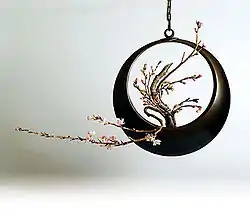花道
Chinese
flower; blossom; to spend flower; blossom; to spend; fancy pattern |
direction; way; method direction; way; method; road; path; principle; truth; reason; skill; Tao (of Taoism); a measure word; to say; to speak; to talk | ||
|---|---|---|---|
| trad. (花道) | 花 | 道 | |
| simp. #(花道) | 花 | 道 | |
Pronunciation
Synonyms
- 插花 (chāhuā)
Japanese
Etymology 1
| Kanji in this term | |
|---|---|
| 花 | 道 |
| か Grade: 1 |
どう Grade: 2 |
| kan’on | goon |
/kwadau/ → /kwadɔː/ → /kwadoː/ → /kadoː/
From Middle Chinese 花道 (MC xwae dawX).
Usage notes
This term became more common during the Edo period as a synonym for ikebana, but with an emphasis on the elements of mental discipline.[1][2][3]
The 華道 spelling may be more common for the kadō reading, to more clearly distinguish from the hanamichi reading below.
Etymology 2

| Kanji in this term | |
|---|---|
| 花 | 道 |
| はな Grade: 1 |
みち Grade: 2 |
| kun’yomi | |
Compound of 花 (hana, “flower”) + 道 (michi, “road, way”).[1][2][4]
Likely derives from the early use of a hanamichi as a kind of walkway from the stage down into the audience, giving performers access to the audience in order to receive flowers.[1][2]
Noun
花道 • (hanamichi)
References
- Matsumura, Akira, editor (2006), 大辞林 [Daijirin] (in Japanese), Third edition, Tōkyō: Sanseidō, →ISBN
- Shōgaku Tosho (1988) 国語大辞典(新装版) [Unabridged Dictionary of Japanese (Revised Edition)] (in Japanese), Tōkyō: Shogakukan, →ISBN
- “花道”, in 世界大百科事典 第2版 (Sekai Dai-hyakka Jiten Dainihan, “Heibonsha World Encyclopedia Second Edition”) (in Japanese), Tōkyō: Heibonsha, 1998
- Matsumura, Akira (1995) 大辞泉 [Daijisen] (in Japanese), First edition, Tōkyō: Shogakukan, →ISBN
This article is issued from Wiktionary. The text is licensed under Creative Commons - Attribution - Sharealike. Additional terms may apply for the media files.
